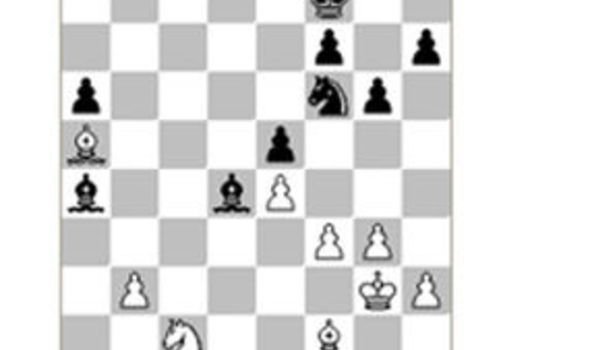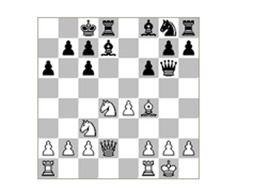CHESS - 13/6/10 Express.co.uk

Chess diagram 1
Sunday June 13,201
FOR some players, improvement comes in fits and starts, but the Ukrainian grandmaster Pavel Eljanov's rise into the world’s top ten has been gradual and consistent.
Eljanov is currently his country's top player, just slightly ahead of Vasily Ivanchuk.
I'm pleased to say that we play for the same team (Werder Bremen) in the German chess Bundesliga.
Cementing his place at the top, Eljanov took first place with 8/13 at the sixth and final Fide Grand Prix tournament in Astrakhan last month.
Ponomariov, Jakovenko, Mamedyarov, Alekseev and Radjabov all shared second place on 7/13.
The quality of chess was very high, but there were few spectacular games.
This is a nice example though, where some subtle and precise play enabled Eljanov to squeeze a full point from an almost dead position (see diagram 1).
I'm pleased to say that we play for the same team (Werder Bremen) in the German chess Bundesliga.
Cementing his place at the top, Eljanov took first place with 8/13 at the sixth and final Fide Grand Prix tournament in Astrakhan last month.
Ponomariov, Jakovenko, Mamedyarov, Alekseev and Radjabov all shared second place on 7/13.
The quality of chess was very high, but there were few spectacular games.
This is a nice example though, where some subtle and precise play enabled Eljanov to squeeze a full point from an almost dead position (see diagram 1).
 |
| Chess diagram 2 |
Pavel Eljanov - Vladimir Akopian
(Astrakhan, 2010)
36.b3 After 36.Bxa6 Bxb2 the players could shake hands immediately, but this keeps the game going a little longer. 36...Bb5 37.Bxb5 axb5 38.Ne2! Posing a little problem, as allowing Nxd4 would leave a very weak pawn on d4. 38...Bb2 Care is already required. 38...Bc5? loses a pawn immediately after 39.Nc3 b4 40.Na2. 39.Bb4+! A nice idea, setting a trap just before the time control, which Akopian falls into.
39...Ke8? An unfortunate square. 39...Kg7 40.Bc3 Bxc3 41.Nxc3 Nd7! allows Black to save the draw comfortably. 42.Nxb5 (42.b4 Nb8!) 42...Nc5 43.b4 Nd3 and the pawn is recovered. 40.Bc3! Bxc3 41.Nxc3 Kd7 Black can't save the pawn now, because his king is vulnerable to a check: 41...Nd7 42.Nxb5 Nc5 43.b4 Nd3 44.Nc7+ Kd7 45.Nd5 and so on. 42.Nxb5 Kc6 43.Nc3 Kc5 44.g4! h6 44...Kb4 Loses by force.
45.Nd5+ Nxd5 46.exd5 Kc5 47.g5! Kxd5 48.Kf2 One pawn holds up three on the kingside, and White can use the b-pawn as a decoy while his king advances, so Black is lost here. 45.h4 Nd7 46.Nd5 With black's king so active, the win is still not trivial but Eljanov brought home the full point before long. 46...f5 47.b4+ Kd4 48.exf5 gxf5 49.Ne7 fxg4 50.fxg4 e4 51.Nf5+ Kd3 52.b5 Kc4 53.Nxh6 Kxb5 54.g5 Ne5 55.h5 e3 56.Nf5 e2 57.Nd4+ Kc4 58.Nxe2 Kd5 59.Kg3 Ke6 60.Nd4+ Kf7 61.Kf4 Nc4 62.Nf5 Nb6 63.g6+ Kf6 64.Ne3 1–0
(Astrakhan, 2010)
36.b3 After 36.Bxa6 Bxb2 the players could shake hands immediately, but this keeps the game going a little longer. 36...Bb5 37.Bxb5 axb5 38.Ne2! Posing a little problem, as allowing Nxd4 would leave a very weak pawn on d4. 38...Bb2 Care is already required. 38...Bc5? loses a pawn immediately after 39.Nc3 b4 40.Na2. 39.Bb4+! A nice idea, setting a trap just before the time control, which Akopian falls into.
39...Ke8? An unfortunate square. 39...Kg7 40.Bc3 Bxc3 41.Nxc3 Nd7! allows Black to save the draw comfortably. 42.Nxb5 (42.b4 Nb8!) 42...Nc5 43.b4 Nd3 and the pawn is recovered. 40.Bc3! Bxc3 41.Nxc3 Kd7 Black can't save the pawn now, because his king is vulnerable to a check: 41...Nd7 42.Nxb5 Nc5 43.b4 Nd3 44.Nc7+ Kd7 45.Nd5 and so on. 42.Nxb5 Kc6 43.Nc3 Kc5 44.g4! h6 44...Kb4 Loses by force.
45.Nd5+ Nxd5 46.exd5 Kc5 47.g5! Kxd5 48.Kf2 One pawn holds up three on the kingside, and White can use the b-pawn as a decoy while his king advances, so Black is lost here. 45.h4 Nd7 46.Nd5 With black's king so active, the win is still not trivial but Eljanov brought home the full point before long. 46...f5 47.b4+ Kd4 48.exf5 gxf5 49.Ne7 fxg4 50.fxg4 e4 51.Nf5+ Kd3 52.b5 Kc4 53.Nxh6 Kxb5 54.g5 Ne5 55.h5 e3 56.Nf5 e2 57.Nd4+ Kc4 58.Nxe2 Kd5 59.Kg3 Ke6 60.Nd4+ Kf7 61.Kf4 Nc4 62.Nf5 Nb6 63.g6+ Kf6 64.Ne3 1–0
The Association of Chess Professionals Rapid Cup began in Odessa just a few days after Astrakhan, with some of the same players competing, including Eljanov.
Pavel was knocked out by Jakovenko in the quarter finals.
It was Sergey Karjakin who won the event, riding his luck on various occasions.
There was no shortage of colourful games in Odessa, including this gem won by the eventual runner-up.
Dmitry Jakovenko - Ernesto Inarkiev
(Odessa, 2010)
1.e4 e5 2.Nf3 Nc6 3.Bb5 a6 4.Bxc6 dxc6 5.0–0 Qf6 6.d4 exd4 7.Bg5 Qd6 8.Nxd4 Bd7 9.Nc3 Qg6 10.Qd2 f6 11.Bf4 0–0–0 (see diagram 2)
12.Ncb5!! An astonishing breakthrough which gives White a huge advantage. The weakness of c7 is highlighted, but the combination turns on various tactical details. 12...cxb5 12...axb5? 13.Qa5 wins. 12...Bh3 13.Na7+ Kb8 (13...Kd7!? might have been a brave practical try to cause confusion, but after 14.Bg3! Ke8 15.Qc3 White maintains a big advantage) 14.Ndxc6+ bxc6 15.Qxd8+ Kxa7 16.Qxc7+ Ka8 17.Qb8 mate.
Another beautiful twist is 12...Bc5 13.Qa5 Bb6 14.Qxb6!! cxb6 15.Na7 mate. 13.Qc3 Bc6 13...Bd6 14.Bxd6 Bc6 would also be a reasonable attempt, but after 15.Nxc6 Rxd6 16.Qh3+ f5 17.Ne5 White wins a clear pawn. 14.Nxc6 bxc6? Black still had reasonable practical chances to resist with 14...Rd7 15.Rad1 Qg4 but White has the initiative and a better structure. 15.Qxc6 Bd6 16.Rad1! Winning material by force.
Black struggles on but now the result is never in doubt. 16...Qe8 17.Rxd6 Qxc6 18.Rxc6 Rd7 19.Rxa6 Kb7 20.Ra5 c6 21.Be3 Kb8 22.a4 b4 23.Bc5 Nh6 24.Bxb4 Rd4 25.Bc3 Rxe4 26.Rd1 Rhe8 27.h3 R4e7 28.Rh5 Nf7 29.Rxh7 Ng5 30.Rh4 Re2 31.Rb4+ Kc7 32.Rbd4 Rxc2 33.Rd7+ Kb6 34.a5+ Ka6 35.Rxg7 Ree2 36.Bxf6 Ne4 37.Bd4 c5 38.Be3 Nxf2 39.Bxf2 Rxf2 40.Rd5 Rfe2 41.b4 cxb4 42.Rg6+ Kb7 43.Rb5+ Kc7 44.Rxb4 1–0





No comments:
Post a Comment